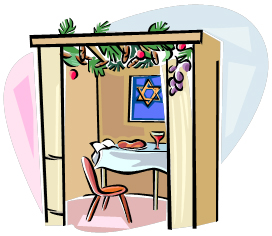
Immediately after the breaking of the fast on Yom Kippur, the sound of hammers tapping can be heard in Jewish neighborhoods. A start is made in building the temporary booth or SUKKAH, in a backyard or on a balcony, which will be the center of the week-long Festival celebration. The booths, or sukkot, symbolize the temporary shelters that housed the Israelites during their forty-year journey through the wilderness en route to the Promised Land. A sukkah must have at least three walls and be big enough to eat a meal inside it. The main message of the sukkah lies in the fact that it is a temporary dwelling. It reminds us that our lives on earth are also temporary and just as God protected, guided and provided for His people on their precarious travels through the wilderness, so our Father will care for us as we undertake our tenuous journey through this world. As His children, we can joyfully, in complete faith and trust, rest in the knowledge that our true shelter is found in His constant Presence.
In the Bible, Sukkot is referred to simply as HaChag, “The Feast” (Leviticus 23:39-43). The commandment to celebrate it is found in Leviticus 23:42-43, “Every citizen in Israel shall dwell in sukkot (booths), so that your descendants shall know that in sukkot I caused the Children of Israel to dwell when I brought them out of the land of Egypt.“
For forty years, as our ancestors traversed the Sinai Desert prior to their entry into the Holy Land, miraculous "clouds of glory" surrounded and hovered over them, shielding them from the dangers and discomforts of the desert. Ever since, we remember God's kindness and reaffirm our trust in His providence by dwelling in a sukkah--a hut of temporary construction with a roof covering of branches—for the duration of the Sukkot festival (Tishrei 15-21). For seven days and nights, we eat all our meals in the sukkah and otherwise regard it as our home.
Another Sukkot observance is the taking of the “Four Kinds”—an etrog (citron), a lulav (palm frond), three hadassim (myrtle twigs) and two aravot (willow twigs). On each day of the festival (excepting Shabbat), we take the Four Kinds, recite a blessing over them, bring them together in our hands and wave them in all six directions: right, left, forward, up, down and backward. The Midrash tells us that the Four Kinds represent the various types and personalities that comprise the community of Israel, whose intrinsic unity we emphasize on Sukkot.
Sukkot is also called The Time of Our Joy; indeed, a special joy pervades the festival. Nightly Water-Drawing Celebrations, reminiscent of the evening-to-dawn festivities held in the Holy Temple in preparation for the drawing of water for use in the festival service, fill the synagogues and streets with song, music and dance until the wee hours of the morning.
The seventh day of Sukkot is called Hoshana Rabbah ("Great Salvation") and closes the period of Divine judgment begun on Rosh Hashanah. A climax of the Sukkot celebration in the Holy Temple was the water pouring ceremony. The High Priest poured water from a golden pitcher onto the altar. The water had been collected from the Pool of Siloam, the main water source for the city of Jerusalem. Water represents life and, after the long, dry summer, prayers are now offered for God’s provision of the first rains. It was at this vital moment of water-pouring that Yeshua made a loud proclamation in the Temple Court: On the last day of HaChag, the Feast, the great day, Yeshua stood up and proclaimed, "If any one thirst, let him come to me and drink. He who believes in me, as the Scripture has said, ‘Out of his heart shall flow rivers of living water'" (John 7:37-38).